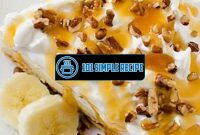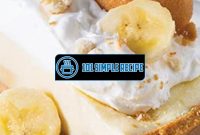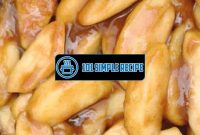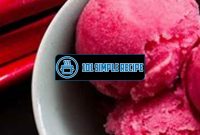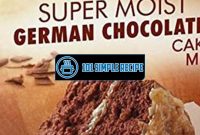Are you ready to become a master baker? Look no further than this irresistible and indulgent Double Layer Vanilla and Chocolate Cake recipe. Whether you are a seasoned baker or just starting out, this recipe will guide you through the art of baking a cake that is not only visually stunning but also incredibly delicious. The combination of moist vanilla sponge layers and rich chocolate ganache filling is guaranteed to satisfy your sweet tooth and impress your friends and family. So tie on your apron, preheat your oven, and let’s get ready to bake a masterpiece!
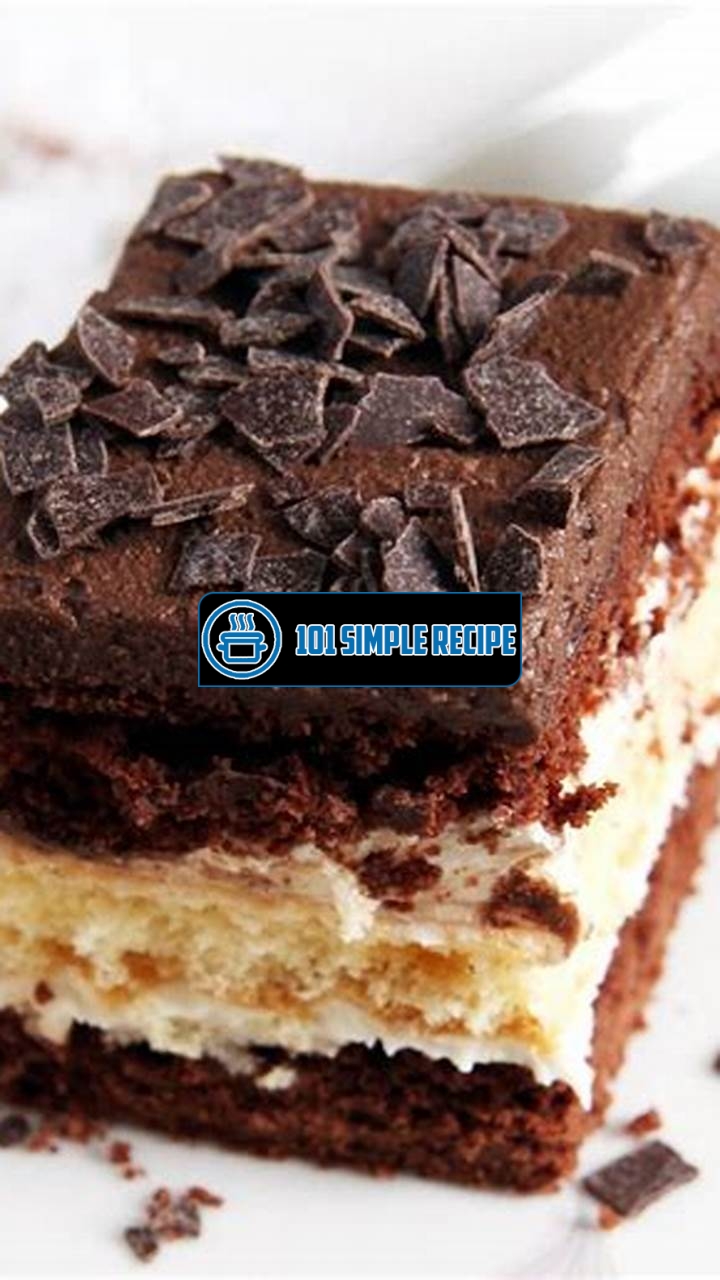
The History of Layered Cakes
In the world of desserts, layered cakes have always been a beloved treat. These delectable creations consist of multiple layers of cake, usually separated by frosting or other fillings. The art of creating layered cakes has a rich history that dates back centuries, with the recipes and techniques evolving over time. Let’s delve into the origins of layered cakes and explore how they have become a staple in the world of baking.
Early Variations of Layered Cakes
The concept of layered cakes can be traced back to ancient civilizations. Egyptians and Greeks were known to bake bread with honey and layer them together, creating a primitive version of the layered cake. However, it wasn’t until the Middle Ages in Europe that layered cakes as we know them today started to take shape.
During the Renaissance period, cakes became more elaborate, and layering cakes with sweet fillings became popular. With the availability of new ingredients such as sugar, butter, and spices, bakers began experimenting with different flavors and textures. Layered cakes became a symbol of celebration and were often served at important events and weddings.
Influence of French Patisserie
The French played a significant role in shaping the art of layered cakes. French patisserie techniques brought finesse and elegance to the world of baking, introducing light and airy sponge cakes and delicate frostings.
In the 17th and 18th centuries, French bakers developed the technique of creating sponge cakes using beaten eggs and flour, which resulted in lighter and more tender layers. They also perfected the art of pipeable buttercream, enabling the creation of intricate decorations and frostings for layered cakes.
The famous French opera cake, known for its elegant layers of almond sponge cake, coffee buttercream, and chocolate ganache, further exemplifies the French influence on layered cakes. The delicate balance of flavors and textures in these French creations continues to inspire pastry chefs worldwide.
Modern Techniques and Innovations
In the modern era, layered cakes have seen a resurgence in popularity with the advent of new techniques and innovations. The emergence of electric mixers, ovens with precise temperature control, and a wide range of ingredients has revolutionized the way layered cakes are made.
Bakers now have access to a vast array of flavors, fillings, and decorations, allowing them to experiment and create unique and personalized layered cake recipes. From classic combinations like chocolate and vanilla to exotic flavors like matcha and coconut, the possibilities are endless.
Advancements in cake decorating tools and techniques have also opened up new avenues for creativity. From beautifully piped flowers to intricate fondant designs, bakers can now transform layered cakes into edible works of art.
The history of layered cakes is a testament to the evolution of baking techniques and the endless creativity of pastry chefs. Whether it’s a simple homemade creation or an elaborate masterpiece from a renowned bakery, a double layer vanilla and chocolate cake recipe will always hold a special place in the hearts of cake enthusiasts worldwide.
The Perfect Cake Base
When it comes to creating a double layer vanilla and chocolate cake, the key to success lies in the perfect cake base. Your base sets the stage for a moist and flavorful cake that will have your guests begging for seconds. In this section, we will explore the essential components that will elevate your cake base to new heights.
Flour Selection and Ratios
The first step in creating the perfect cake base is selecting the right flour and determining the ratios. For a light and delicate texture, it is crucial to choose a cake flour with a low protein content. Cake flour has a finer texture and lower protein content compared to all-purpose flour, resulting in a tender and moist cake.
When it comes to ratios, striking the right balance is essential. It is typically recommended to use equal parts cake flour and all-purpose flour for a double layer vanilla and chocolate cake. This combination provides the best of both worlds – the tenderness of cake flour and the structure of all-purpose flour.
Importance of Quality Fats
Quality fats play a vital role in creating a rich and delicious cake base. When choosing fats for your cake recipe, opt for high-quality ingredients such as unsalted butter or vegetable shortening. These fats not only add moisture but also contribute to the flavor profile of your cake.
For a double layer vanilla and chocolate cake, consider using a combination of butter and vegetable shortening. Butter adds a creamy and luxurious taste, while vegetable shortening helps to create a moist and tender crumb. The ratio of these fats can be adjusted according to personal preference, ensuring the perfect balance of flavor and texture.
Adding Depth of Flavor
No cake base is complete without the addition of flavor enhancements. To elevate your double layer vanilla and chocolate cake, consider incorporating ingredients that add depth and complexity to the overall taste.
One option is to use quality vanilla extract. Vanilla extract adds a sweet and aromatic flavor that pairs perfectly with both vanilla and chocolate cakes. Additionally, you can experiment with other flavorings such as almond extract or espresso powder to create a more unique and decadent cake.
Another way to add depth of flavor is to incorporate high-quality chocolate into your cake base. Whether it’s through the use of cocoa powder or melted chocolate, adding chocolate will take your cake to a whole new level of indulgence.
By following the guidelines for flour selection and ratios, using quality fats, and adding depth of flavor, you can master the art of creating a double layer vanilla and chocolate cake with an irresistible cake base. These essential components will ensure that your cake is moist, flavorful, and a true showstopper at any gathering.
Mastering the Vanilla Layer
Learn the secrets to baking a delicate and aromatic vanilla cake layer. In this section, we will explore three important aspects of creating a perfect vanilla layer in your double-layer vanilla and chocolate cake recipe: using high-quality vanilla extract, enhancing with vanilla bean seeds, and ensuring a light and tender texture.
Using High-Quality Vanilla Extract
One of the key ingredients in a vanilla cake layer is the vanilla extract. To achieve a rich and flavorful taste, it is crucial to use high-quality vanilla extract. Avoid artificial extracts and opt for pure vanilla extract that is made from real vanilla beans. This will ensure an authentic and intense vanilla flavor in your cake.
Pro Tip: Look for bottles labeled with “pure vanilla extract” and check the ingredient list to ensure it doesn’t contain any additives or artificial flavors.
Enhancing with Vanilla Bean Seeds
To take your vanilla layer to the next level, consider adding vanilla bean seeds to the batter. Vanilla bean seeds contain tiny black specks that not only add visual appeal but also contribute to a more intense and complex vanilla flavor. To extract the seeds from a vanilla bean, split the bean in half lengthwise with a sharp knife and use the back of the knife to scrape out the seeds. Mix the seeds into the cake batter for a delightful burst of flavor.
Pro Tip: Don’t throw away the emptied vanilla bean pod! You can place it in a jar of sugar to infuse the sugar with a subtle vanilla flavor. This vanilla-infused sugar can be used in various other recipes.
Ensuring a Light and Tender Texture
In addition to a heavenly vanilla flavor, a perfect vanilla cake layer should have a light and tender texture. Achieving this requires attention to detail during the mixing process. Here are a few essential steps:
- Sift the dry ingredients: Before adding the dry ingredients to the batter, sift them together to remove any lumps. This will create a smoother texture in the final cake.
- Cream the butter and sugar: Creaming the butter and sugar together creates air pockets, resulting in a lighter and fluffier cake. Beat them together until light and creamy.
- Alternate adding dry and wet ingredients: When incorporating the dry ingredients and liquid ingredients into the creamed butter mixture, alternate between the two. This helps to evenly distribute everything and prevents overmixing.
- Be gentle when folding: When adding the dry ingredients to the batter, fold them in gently using a spatula or wooden spoon. Overmixing can result in a dense and tough cake.
Pro Tip: Remember to preheat your oven to the correct temperature and bake the vanilla layer for the recommended time. Avoid opening the oven door too often while baking, as this can cause the cake to sink or become uneven.
Make sure to follow these tips for mastering the vanilla layer in your double-layer vanilla and chocolate cake. By using high-quality vanilla extract, enhancing with vanilla bean seeds, and ensuring a light and tender texture, you’ll create a vanilla cake layer that will impress everyone!
Achieving the Perfect Chocolate Layer
When it comes to baking a double layer vanilla and chocolate cake, the chocolate layer is undoubtedly the star of the show. Achieving a rich and decadent chocolate cake layer requires specific techniques that will elevate your baking skills. In this section, we will uncover the secrets behind creating the perfect chocolate layer for your cake.
Choosing the Right Cocoa Powder
The choice of cocoa powder plays a crucial role in the flavor and texture of your chocolate cake layer. To achieve a deep and intense chocolate flavor, opt for a high-quality unsweetened cocoa powder. This type of cocoa powder contains a higher percentage of cocoa solids, resulting in a richer and more robust taste.
Pro Tip: Look for cocoa powder labeled as “Dutch-processed” or “alkalized” as it has been treated with alkali to neutralize its acidity. This process enhances the smoothness and mellow taste of the cocoa powder.
Adding Melted Chocolate for Intensity
In addition to cocoa powder, adding melted chocolate to your cake batter will intensify the chocolate flavor and contribute to a moist texture. When selecting the chocolate for melting, opt for good quality dark chocolate with at least 60% cocoa content. Dark chocolate contains less sugar and imparts a more pronounced chocolate taste.
Pro Tip: Use a heatproof bowl set over a pot of simmering water to melt the chocolate. Stir the chocolate occasionally until it becomes smooth and glossy. Be careful not to overheat or burn the chocolate, as this can alter its taste and texture.
Balancing Moisture with Chocolate
When incorporating chocolate into your cake batter, it’s important to strike the right balance of moisture. The chocolate layer should be moist and tender without being overly dense or dry. To achieve this, consider the moisture content of your other ingredients and adjust accordingly.
Pro Tip: To ensure a moist chocolate layer, add a tablespoon or two of sour cream or yogurt to the batter. These dairy ingredients will not only enhance the texture but also add a subtle tanginess that complements the chocolate flavor.
By following these techniques for achieving the perfect chocolate layer, you can elevate your double layer vanilla and chocolate cake into a heavenly dessert. Choose the right cocoa powder, add melted chocolate, and balance the moisture to create a rich and decadent chocolate cake that will impress your friends and family.
Creamy and Fluffy Frosting Options
When it comes to baking a double layer vanilla and chocolate cake, one of the most important elements is the frosting. The right frosting can elevate the flavors of the cake and take it from ordinary to extraordinary. In this article, we will explore various frosting recipes that perfectly complement the rich and indulgent flavors of a double-layered cake. Whether you prefer a classic buttercream frosting, an indulgent chocolate ganache, or a light and airy whipped cream frosting, we’ve got you covered!
Classic Buttercream Frosting
A classic buttercream frosting is a timeless choice for any cake, and it pairs beautifully with the flavors of a double-layered vanilla and chocolate cake. This frosting recipe is rich, creamy, and oh-so-delicious. The combination of butter, powdered sugar, vanilla extract, and a pinch of salt creates a smooth and velvety texture that melts in your mouth. ✨
To make this classic buttercream frosting, you will need the following ingredients:
- 1 cup unsalted butter, softened
- 4 cups powdered sugar
- 2 teaspoons vanilla extract
- Pinch of salt
In a large bowl, cream the softened butter until smooth. Gradually add the powdered sugar, vanilla extract, and salt, and beat until well combined and fluffy. Spread this delightful buttercream frosting generously between the layers and on top of your double-layered cake for a truly indulgent treat!
Indulgent Chocolate Ganache
If you’re a chocolate lover, then an indulgent chocolate ganache frosting is the perfect choice for your double-layer vanilla and chocolate cake. This luxurious frosting adds a glossy and decadent finish to your cake, making it absolutely irresistible.
To make the chocolate ganache, you will need the following ingredients:
- 8 ounces of high-quality dark or semisweet chocolate, chopped
- 1 cup heavy cream
- 1 tablespoon unsalted butter
In a saucepan, heat the heavy cream until it begins to simmer. Remove from heat and add the chopped chocolate and butter. Let it sit for a few minutes to allow the chocolate to melt. Stir until smooth and glossy. Allow the ganache to cool slightly before pouring it over your double-layered cake. The ganache will set into a luscious, velvety layer that will have everyone coming back for seconds!
Light and Airy Whipped Cream Frosting
If you’re looking for a lighter option that still delivers on flavor, a whipped cream frosting is the way to go. This frosting is perfect for those who prefer a less sweet and more refreshing taste. The light and airy texture of the whipped cream pairs beautifully with the moist layers of the vanilla and chocolate cake.
To make the whipped cream frosting, you will need the following ingredients:
- 2 cups heavy cream
- 1/4 cup powdered sugar
- 1 teaspoon vanilla extract
In a chilled bowl, whip the heavy cream until soft peaks form. Add the powdered sugar and vanilla extract, and continue whipping until stiff peaks form. Be careful not to overwhip, as it can lead to a grainy texture. Spread the whipped cream frosting generously on your double-layered cake, and feel free to garnish with fresh berries or chocolate shavings for an extra touch of elegance!
With these three creamy and fluffy frosting options, you’ll be able to master the art of baking a double layer vanilla and chocolate cake. Whether you choose the classic buttercream, indulgent chocolate ganache, or light whipped cream frosting, your cake is sure to be a showstopper! So go ahead and indulge in these delectable frostings to take your cake to the next level of deliciousness. Happy baking!
Frequently Asked Questions
Thank you for reading this article on how to make a delicious double layer vanilla and chocolate cake. We hope you found it helpful and inspiring for your next baking adventure. If you have any questions, please refer to the FAQ section below:
| No. | Questions | Answers |
|---|---|---|
| 1. | Can I substitute the vanilla extract with vanilla essence? | Yes, you can substitute vanilla extract with vanilla essence. However, keep in mind that the flavor might be slightly different. |
| 2. | Can I use almond milk instead of regular milk? | Yes, almond milk can be used as a substitute for regular milk in this recipe. |
| 3. | How long does the cake need to cool before frosting? | Allow the cake to cool completely before frosting, which usually takes around 1-2 hours. |
| 4. | Can I use dark chocolate instead of milk chocolate? | Yes, you can use dark chocolate instead of milk chocolate if you prefer a richer flavor. |
| 5. | How should the cake be stored? | The cake should be stored in an airtight container at room temperature for up to 3 days. |
| 6. | Can I freeze the cake for later? | Yes, you can freeze the cake for up to 2 months. Make sure to wrap it tightly in plastic wrap and aluminum foil before freezing. |
Thank You for Reading!
We hope you enjoyed learning how to make this delightful double layer vanilla and chocolate cake. Now it’s time to put your baking skills to the test and indulge in a slice of homemade goodness. Remember, practice makes perfect, so don’t hesitate to visit us again for more mouthwatering recipes and baking tips. Happy baking!
Jump to Recipe
Double Layer Vanilla and Chocolate Cake Recipe

Learn how to make a delicious double layer vanilla and chocolate cake with this easy-to-follow recipe. Perfect for birthdays, celebrations, or simply satisfying your sweet tooth.
- 1 ½ cups all-purpose flour
- ¼ cup cocoa powder
- 1 ½ teaspoons baking powder
- ⅛ teaspoon salt
- ½ cup unsalted butter (softened)
- 1 cup granulated sugar
- 2 large eggs
- 1 teaspoon vanilla extract
- ½ cup milk
- ½ cup hot water
- Vanilla frosting
- Chocolate frosting
- Preheat the oven to 350°F (175°C). Grease and flour two 9-inch round cake pans.
- In a medium bowl, sift together the flour, cocoa powder, baking powder, and salt.
- In a large mixing bowl, cream together the softened butter and sugar until light and fluffy.
- Add the eggs one at a time, beating well after each addition. Stir in the vanilla extract.
- Gradually add the dry ingredients to the butter mixture, alternating with the milk. Mix until just combined.
- Stir in the hot water until the batter is smooth.
- Divide the batter evenly between the prepared pans.
- Bake for 30-35 minutes, or until a toothpick inserted into the center of the cakes comes out clean.
- Allow the cakes to cool in the pans for 10 minutes, then transfer them to a wire rack to cool completely.
- Once the cakes are completely cooled, frost one layer with vanilla frosting and the other layer with chocolate frosting.
- Gently place one layer on top of the other to create a double layer cake.
- Serve and enjoy!

